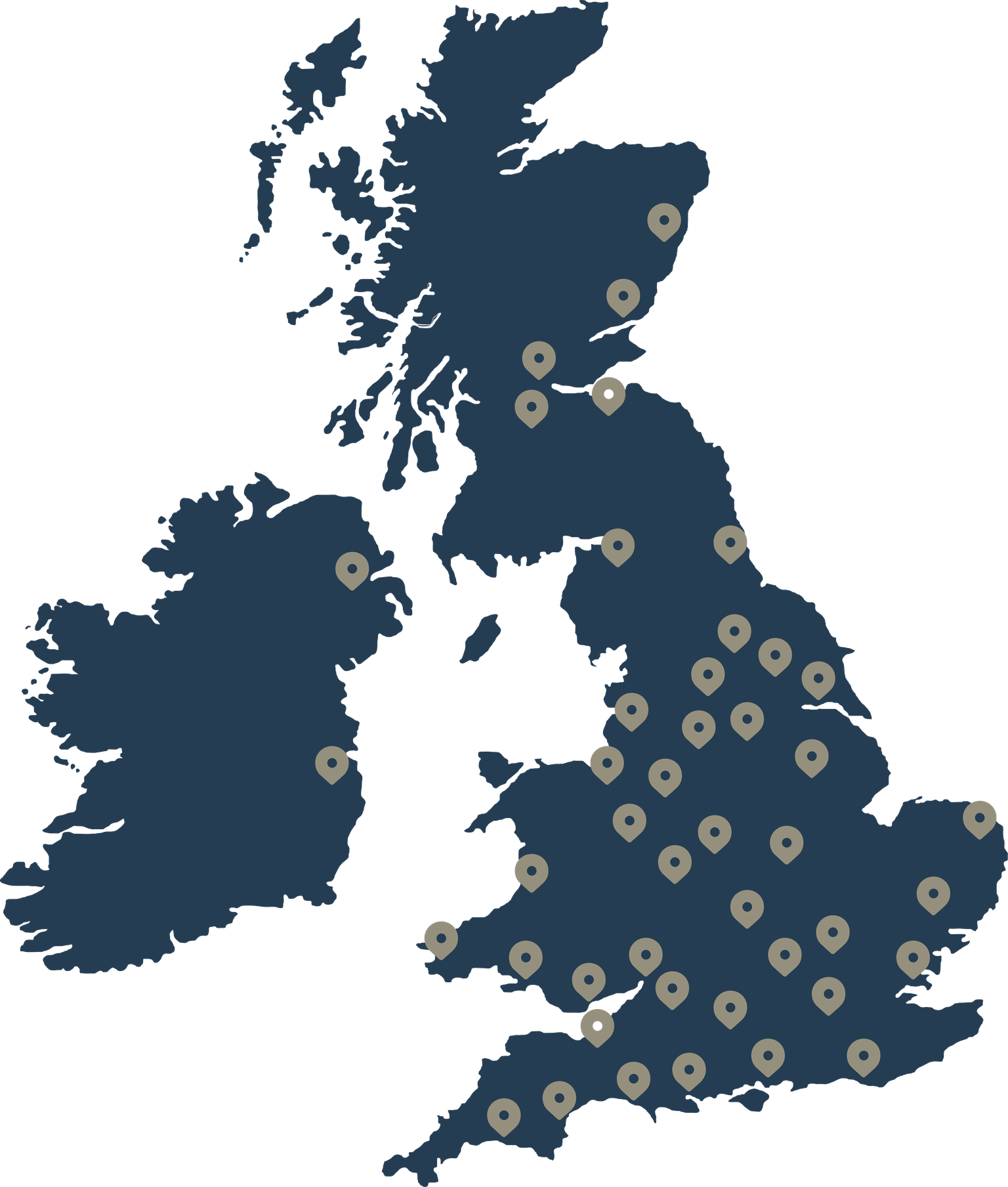Chronic obstructive pulmonary disease (COPD) affects more than 14 million adults in the U.S.1 The condition can cause a range of symptoms, including shortness of breath, frequent chest infections, persistent wheezing, and a chesty cough.
Many things, such as exposure to certain fumes, chemicals, or air pollution, can cause or worsen COPD. Humidity and temperature can also play a big part, with the optimum brackets for these factors being between 40 and 60% humidity2, and 66.6 and 77˚F3. Extreme humidity or temperatures can often irritate the airways and make it harder for the lungs to function correctly.
Elevating the head, upper body, and legs can help to improve circulation and reduce pressure on the lungs. Home hospital beds can be adjusted to a semi-upright position and are designed to provide comfort and improve the health of those living with conditions like COPD.
With this in mind, we’ve analyzed various factors such as smoking rates, average humidity, and toxic releases to determine the best U.S. states for lung health.
Which U.S states are the best for lung health?
According to our data, the West Coast is the best place to live in the U.S. in terms of lung health. Six of the top 10 states are located on the western side of the country, with Colorado, Hawaii, and New Mexico making up the top three. This suggests that those on the West Coast may be less likely to develop respiratory conditions like COPD, due to better air quality, humidity levels, and average temperatures. It may also be a viable option for those relocating to another state to improve their lung health.

|
Rank |
State |
Current adult smoking rate |
Air pollution exposure (µg/m³) |
Toxic releases (lbs per sq mile) |
Average relative humidity |
% of population covered by smokefree indoor air policies |
Average temperature (˚F) |
Lung health score |
|
1 |
Colorado |
10.7% |
6.6 |
195.54 |
54.1% |
100.0% |
46.3 |
9.11 |
|
1 |
Hawaii |
10.0% |
4.3 |
235.25 |
73.3% |
100.0% |
70.2 |
9.11 |
|
3 |
New Mexico |
15.0% |
6.7 |
177.54 |
45.9% |
100.0% |
54.5 |
8.87 |
|
4 |
Maryland |
9.6% |
6.8 |
453.46 |
68.8% |
100.0% |
55.5 |
8.80 |
|
5 |
Nebraska |
13.0% |
6.2 |
218.96 |
65.8% |
100.0% |
49.5 |
8.43 |
|
6 |
California |
9.7% |
12.7 |
255.80 |
61.0% |
100.0% |
59.1 |
8.36 |
|
7 |
South Dakota |
14.0% |
5.9 |
111.69 |
66.4% |
100.0% |
45.8 |
8.33 |
|
7 |
Connecticut |
10.0% |
7.4 |
284.71 |
69.2% |
100.0% |
50.0 |
8.33 |
|
9 |
Rhode Island |
11.8% |
6.6 |
250.67 |
71.4% |
100.0% |
50.8 |
7.89 |
|
10 |
New Jersey |
10.4% |
7.4 |
1,259.28 |
68.5% |
100.0% |
53.6 |
7.75 |
1. Colorado - 9.11/10 lung health score
Topping the list is Colorado, earning a lung health score of 9.11 out of 10. Just 10.7% of adults living in Colorado currently smoke, and smoking is banned at all restaurants, bars, and non-hospitality workplaces. Over the last two decades, the state has introduced multiple practices to reduce smoking rates, including raising the price of tobacco and the age at which you can buy it.4
Colorado residents are exposed to air pollution at 6.6 µg/m³, notably below the national average of 8.6. In addition, just 195.54 lbs of toxins are released per square mile in the state, the sixth lowest figure of all states, possibly due to Colorado monitoring roadside emissions, using remote sensing technologies to identify high-emitting cars. Denver, the state’s capital, also offers free public transportation in some high-ozone summer months.5
1. Hawaii - 9.11/10 lung health score
Hawaii also has a lung health score of 9.11. Like Colorado, Hawaii has banned smoking at all restaurants, bars, and non-hospitality workplaces. In addition, just 10% of the state’s adult population smokes, the fourth lowest figure on the list. Hawaii was the first state to raise the legal age of smoking to 21 years6 and has also introduced multiple state and community-wide intervention programs to prevent tobacco use.7
While Hawaii scores highly overall, the state has an average relative humidity of 73.3%, which is 13.3% higher than the ideal bracket. However, temperatures average at 70.2˚F in Hawaii, falling perfectly within the optimum temperature bracket for lung health.
Around 235.25 lbs of toxins are released per square mile in the state, and Hawaii citizens are exposed to just 4.3 µg/m³, the lowest figure of all states. The state’s location in the Pacific Ocean means that trade winds can help disperse and dilute pollutants from other regions.8
3. New Mexico - 8.87/10 lung health score
New Mexico places third thanks to air pollution of 6.7 µg/m³, below the national average, and just 177.54 lbs of toxins per square mile. Despite being the second largest producer of oil and the fourth largest natural gas producer in the U.S., New Mexico has made a significant effort to cut climate pollution. For example, the state has set a greenhouse gas reduction target of 45% by 2030 and net-zero emissions by 2050.9
The state's average temperature is 54.5˚F, which is 9.9˚F lower than the optimum temperature bracket. It also has an average relative humidity of 45.9%, meaning it falls within the ideal humidity bracket for lung health. This helps ease the effects of extreme summer and winter temperatures on the respiratory system.10
What are the worst U.S. states for lung health?
The East Coast dominates the top 10 worst states for lung health, with all states except Alaska and Nevada located on the country's eastern side. Many potential reasons include the lack of 100% smokefree air laws. Three states in the top 10 have zero laws prohibiting smoking at bars, restaurants, and non-hospitality workplaces. In addition, average humidity levels in these 10 states can be extreme, with all of them falling outside the ideal humidity bracket.

|
Rank |
State |
Current adult smoking rate |
Air pollution exposure (µg/m³) |
Toxic releases (lbs per sq mile) |
Average relative humidity |
% of population covered by smokefree indoor air policies |
Average temperature (˚F) |
Lung health score |
|
1 |
Indiana |
16.2% |
9.1 |
3,297.95 |
72.0% |
31.5% |
52.5 |
4.04 |
|
2 |
Ohio |
17.1% |
8.6 |
1,971.28 |
71.5% |
100.0% |
51.8 |
4.72 |
|
3 |
Alaska |
15.9% |
6.3 |
1,167.23 |
77.1% |
47.1% |
28.1 |
4.79 |
|
4 |
Pennsylvania |
14.9% |
9.0 |
1,226.69 |
69.6% |
0.0% |
49.6 |
4.82 |
|
5 |
Michigan |
15.2% |
8.8 |
551.95 |
72.1% |
100.0% |
45.3 |
4.99 |
|
5 |
Nevada |
14.8% |
9.8 |
3,330.97 |
38.3% |
0.0% |
51.1 |
4.99 |
|
7 |
Tennessee |
18.5% |
7.7 |
1,770.54 |
69.4% |
0.0% |
58.5 |
5.27 |
|
8 |
Louisiana |
16.7% |
7.8 |
2,518.58 |
74.0% |
33.0% |
67.2 |
5.44 |
|
9 |
Mississippi |
17.4% |
7.9 |
1,149.53 |
73.6% |
31.9% |
64.3 |
5.47 |
|
10 |
Kentucky |
17.4% |
8.3 |
1,405.60 |
70.3% |
37.2% |
56.4 |
5.57 |
1. Indiana - 4.04/10 lung health score
Our data shows Indiana residents are more likely to have bad lung health, scoring just 4.04 out of 10. In the state, 16.2% of adults currently smoke, and only 31.5% of restaurants, bars, and non-hospitality workplaces have banned smoking indoors. Indiana has one of the lowest tobacco taxes in the country, making smoking more affordable to those living there.11
Indiana citizens are exposed to air pollution at 9.1 µg/m³, 0.5 µg/m³ more than the U.S. average. The state releases 3,297.95 lbs of toxins per square mile, the second-highest figure on the list and well over the national average. Indiana is home to many coal-fired power plants, meaning residents’ lung health could be affected by the masses of toxic chemicals released into the air.12
2. Ohio - 4.72/10 lung health score
Ohio ranks second with a score of 4.72 out of 10. The state releases 1,971.28 lbs of toxins per square mile, and Ohio citizens are exposed to 8.6 µg/m³, matching the national average. Due to its large and dense population and strong industrial presence, Ohio is considered to have relatively poor air quality.13
The state’s average relative humidity is 71.5%, which is 11.5% over the ideal bracket for lung health. Due to its Midwestern location, Ohio is prone to severe weather and often experiences hot and humid summers and cold winters.14 Temperatures average 51.8˚F in Ohio, 12.6˚F lower than the optimum temperature bracket.
3. Alaska - 4.79/10 lung health score
In third place is Alaska, scoring 4.79 out of 10 for lung health. The state’s average temperature is just 28.1˚F, a considerable 36.3˚F lower than the optimum temperature bracket. It also has an average relative humidity of 77.1%, just over 17% outside the ideal humidity bracket. Due to the state's low temperatures, the mountain ranges in Alaska can act as barriers to moisture from the Pacific Ocean, creating a humid atmosphere.15
Almost 16% of adults living in Alaska currently smoke, and just over 47% of the state’s restaurants, bars, and non-hospitality workplaces have banned smoking. In rural areas of the state, it can be more challenging to access support for quitting tobacco, hence Alaska’s relatively high smoking rate.16
Which U.S. state has the lowest COPD rate?

1. Utah - 3.7% COPD rate
Utah has the lowest chronic obstructive pulmonary disease (COPD) rate in the country, and it’s no coincidence that it also holds the title for the lowest adult smoking rate, at just 6.7%. Often labelled a “smoker’s disease,” COPD is closely linked to tobacco use. However, one in four people with COPD have never smoked, suggesting other environmental and healthcare factors also play a role. In Utah’s case, its aggressive Tobacco Prevention and Control Program - which includes quit support, smokefree environment initiatives, and a targeted anti-tobacco marketing campaign - has likely helped keep rates low.17
The state’s climate may also contribute. Utah’s average relative humidity is 51.7%, which falls within the ideal range for respiratory health. Air that isn’t too dry or humid reduces airway irritation and makes it easier for the lungs to function, possibly lowering the risk of developing COPD.
|
Rank |
State |
COPD rate in 2023 |
|
1 |
Utah |
3.7% |
|
2 |
California |
4.2% |
|
3 |
Hawaii |
4.3% |
|
4 |
New Jersey |
4.4% |
|
5 |
Washington |
4.5% |
|
5 |
Minnesota |
4.5% |
|
7 |
Colorado |
4.7% |
|
8 |
Connecticut |
4.9% |
|
9 |
New Mexico |
5.0% |
|
10 |
Texas |
5.1% |
Which U.S. state has the highest COPD rate?

1. West Virginia - 12.6% COPD rate
Approximately 21% of adults in West Virginia currently smoke, the highest figure of all states. As smoking is the leading cause of COPD19, this could be the reason for the state also having the highest COPD rate, standing at 12.6%, nearly double the national average.
West Virginia residents are also exposed to 7.5 µg/m³, 50% higher than the WHO’s guidelines, and 913 lbs of toxins per square mile, which is relatively high. The region’s low average temperature (52.7˚F) and high humidity (69.7%) fall outside ideal COPD comfort ranges, increasing airway resistance and triggering symptoms.
|
Rank |
State |
COPD rate in 2023 |
|
1 |
West Virginia |
12.6% |
|
2 |
Tennessee |
10.2% |
|
3 |
Alabama |
9.0% |
|
3 |
Arkansas |
9.0% |
|
5 |
Louisiana |
8.7% |
|
6 |
Michigan |
8.6% |
|
6 |
Maine |
8.6% |
|
8 |
Missouri |
8.5% |
|
9 |
Indiana |
8.4% |
|
10 |
Ohio |
7.9% |
|
10 |
Oklahoma |
7.9% |
Which U.S. state has seen the most significant decrease in COPD rates?

1. Mississippi - 21.65% decrease in COPD rates since 2018
Between 2018 and 2023, Mississippi saw the most significant reduction in COPD rates of any U.S. state, from 9.7% to 7.6%, a 21.65% drop. Some contributing factors may help explain this decline, like the state’s average air pollution exposure, which sits at 7.9 µg/m³ - slightly below the U.S. average of 8.6 - and its average temperature of 64.3˚F falls within the optimal range for respiratory comfort.
|
Rank |
State |
COPD rate in 2018 |
COPD rate in 2023 |
5-year % change in COPD rate |
|
1 |
Mississippi |
9.7% |
7.6% |
-21.65% |
|
2 |
New Jersey |
5.6% |
4.4% |
-21.43% |
|
3 |
New Mexico |
6.3% |
5.0% |
-20.63% |
|
4 |
Arizona |
7.1% |
5.8% |
-18.31% |
|
5 |
Florida |
8.3% |
6.8% |
-18.07% |
|
6 |
Texas |
6.2% |
5.1% |
-17.74% |
|
7 |
West Virginia |
15.3% |
12.6% |
-17.65% |
|
8 |
Georgia |
7.3% |
6.2% |
-15.07% |
|
9 |
North Carolina |
8.1% |
7.0% |
-13.58% |
|
10 |
Nebraska |
6.3% |
5.5% |
-12.70% |
Which U.S. state has seen the most significant increase in COPD rates?

1. South Dakota - 39.13% increase in COPD rates since 2018
In 2023, South Dakota had a 6.4% COPD rate. Five years prior, this figure stood at 4.6%, showing a considerable 39.13% increase. This increase is despite the state having banned smoking at all restaurants, bars, and non-hospitality workplaces, and a relatively moderate adult smoking rate of 14%.
However, South Dakota’s average temperature of 45.8˚F is 18.6˚F lower than the optimum temperature bracket, and its average relative humidity (66.4%) is 6.4% higher than the ideal humidity bracket. As mentioned previously, this combination can worsen COPD symptoms, making things increasingly difficult for those living with the condition.
Additionally, the increasing presence of wildfire smoke - often drifting from Canada or other parts of the U.S. - has led to persistently poor air quality in the region. News reports have highlighted the return of wildfire smoke across the Dakotas, prompting health warnings due to elevated particulate matter (PM2.5) in the air. These fine particulates are strongly linked to respiratory issues, including developing and worsening COPD symptoms.21
|
Rank |
State |
COPD rate in 2018 |
COPD rate in 2023 |
5-year % change in COPD rate |
|
1 |
South Dakota |
4.6% |
6.4% |
39.13% |
|
2 |
Montana |
6.0% |
7.3% |
21.67% |
|
3 |
Massachusetts |
5.1% |
5.9% |
15.69% |
|
4 |
Wyoming |
6.4% |
7.4% |
15.63% |
|
5 |
Wisconsin |
5.3% |
6.0% |
13.21% |
|
6 |
Idaho |
5.7% |
6.2% |
8.77% |
|
7 |
Virginia |
6.4% |
6.9% |
7.81% |
|
8 |
Hawaii |
4.0% |
4.3% |
7.50% |
|
9 |
Colorado |
4.4% |
4.7% |
6.82% |
|
10 |
Maine |
8.1% |
8.6% |
6.17% |
How do COPD rates in the U.S. differ between genders?
In the U.S., women are more likely than men to be diagnosed with COPD. Around 6.8 million (5.5%) U.S. males are estimated to be living with the condition, compared to almost 8.9 million (6.8%) females22.
The state with the most stark difference in COPD rates is Tennessee, standing at 11.9% for women and 8.5% for men. On the other hand, there is a difference of just 0.2% in Hawaii. 4.4% of females in the state are thought to be living with COPD, as opposed to 4.2% of males. These low rates may be influenced by the state’s focus on preventing and reducing tobacco use.
New Mexico has seen the most significant decrease in the percentage of females diagnosed with COPD, dropping from 7.1% in 2018 to 5.1% in 2023. South Dakota’s female COPD rate has increased the most, rising by 33.33%.
Similarly, South Dakota has also seen the most significant increase in male COPD rates, jumping from 5% to 7.1% within five years. New Jersey has seen the most significant decrease, at 35.19%.
These differences may be due to state-level differences in smoking rates, support systems, or healthcare access.
Methodology:
We began by using the American Lung Association to collect the adult smoking rate for each state.
Next, we used America’s Health Rankings to discover each state's micrograms of air pollution per cubic meter.
We then used the EPA to gather the lbs of toxins released per square mile in each state.
Next, we used Forbes to collect the average relative humidity in each state before calculating how far this percentage was outside of the ideal humidity bracket.
We then used America’s Health Rankings to discover the percentage of each state’s population covered by 100% smoke-free laws for restaurants, bars, and non-hospitality workplaces.
Next, we used Data Pandas to gather the average temperature in each state before calculating the number of degrees outside the optimum temperature bracket.
Finally, we gave each of the six factors a normalized score out of 10 before taking an average across all factors to form our lung health score.
We then used America’s Health Rankings to collect overall, female, and male COPD rates for 2018 and 2023 in each state. Kentucky and Pennsylvania were removed from this section because no 2023 data was available.
All data was collected on 28 May 2025.
1 https://www.nhlbi.nih.gov/health/copd#:~:
2 https://pmc.ncbi.nlm.nih.gov/articles/PMC10253274/
3 https://www.asthmaandlung.org.uk/living-with/cold-weather
4 https://www.tobaccofreeco.org/the-real-story/#:~:
5 https://pmc.ncbi.nlm.nih.gov/articles/PMC10919081/#:~:
6 https://www.thelancet.com/journals/lanres/article/PIIS2213-2600(15)00366-5/fulltext#:~:
8 https://alohastatedaily.com/2025/05/08/report-honolulu-has-the-cleanest-air-across-the-country/
9 https://www.momscleanairforce.org/nm-cuts-oil-and-gas-pollution/
10 https://weather.nmsu.edu/climate/about/
11 https://www.rmff.org/smoking-and-vaping-the-cost-to-indiana/#:~:
13 https://www.iqair.com/usa/ohio
14 https://glisa.umich.edu/division/central-ohio/#:~:
15 https://www.nps.gov/subjects/aknatureandscience/climate.htm#:~:
17 https://ibis.utah.gov/ibisph-view/indicator/complete_profile/CigSmokAdlt.html#:~:
18 https://www.andersoneng.com/what-you-need-to-know-about-air-pollution-in-utah/#:~:
20 https://billstatus.ls.state.ms.us/documents/2024/html/HB/0001-0099/HB0046IN.htm#:~:
21 https://www.thedakotascout.com/p/canadian-wildfire-smoke-returns-another







